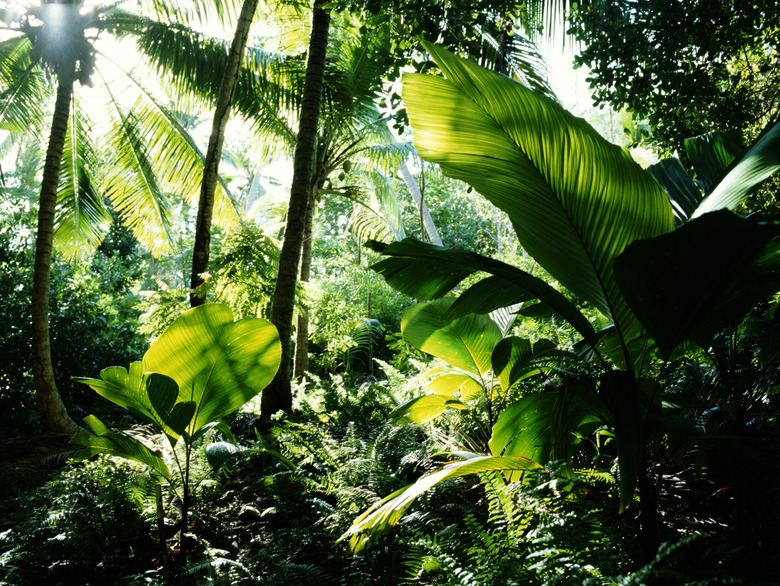What Is A Producer In An Ecosystem?
Ecosystems represent the interaction of living organisms with the environment around them. Within ecosystems, those organisms make up trophic levels, or feeding relationships, commonly depicted in food chains and food webs. A producer in an ecosystem is an organism that produces its own food, such as plants and algae. Producers typically use the sun's energy to make glucose via photosynthesis.
TL;DR (Too Long; Didn't Read)
A producer in an ecosystem is the baseline part of a food chain. Producers include plants, bacteria, algae and phytoplankton. Organisms that eat producers are called consumers, and organisms that consume dead organisms are called decomposers. They all participate in the complex web of an ecosystem.
What Are Producers in Ecology?
What Are Producers in Ecology?
Producers are organisms that produce their own food. They are one part of the food chain in an ecosystem. Other components are consumers, which eat producers or other consumers.
Two types of consumers are primary consumers and secondary consumers. Primary consumers eat producers. An example would be herbivores such as cows being a primary consumer of grass, a producer.
Animals that eat other animals are considered secondary consumers. An apex predator is a consumer at the top of a food chain. An example of an apex predator might be a bird of prey that consumes a mouse, a primary consumer of a producer like grass or seeds.
Decomposers are the organisms that break down dead organisms. Examples of decomposers include fungi and bacteria. Decomposers essentially recycle matter, which becomes available for producers to absorb via their root systems.
All of these actions keep energy flowing in an ecosystem and make up a food web. Each type of organism plays a role, and the interdependence of them all keeps an ecosystem healthy.
What Is a Producer’s Job in an Ecosystem?
What Is a Producer's Job in an Ecosystem?
Producers, namely plants, phytoplankton, bacteria and algae, form the foundation of an ecosystem's food chain. First, plants take the sun's energy to perform photosynthesis, a process used to make organic compounds called carbohydrates. Examples of carbohydrates include sugar and starch.
These compounds feed the producers. They also provide food throughout the food chain, which primary consumers, secondary consumers and apex predators (or tertiary consumers) benefit from, rounding out the chain.
One exception to the photosynthesis option for primary producers is that of using chemosynthesis. Chemosynthesis occurs in some ocean-dwelling producers, which produce their food by using chemicals from hydrothermal vents and other geological structures.
Producers as the Cornerstone of an Ecosystem
Producers as the Cornerstone of an Ecosystem
These interactions are very codependent on one another but ultimately could not exist without the producers. The many parts of a producer can feed several kinds of organisms. For example, plants make seeds, fruit, leaves, roots and nectar to feed different animals. Insects, birds, amphibians, fish, reptiles and mammals all benefit in some way from producers.
They might benefit as primary consumers (herbivores who eat only plants) or as carnivores (secondary and tertiary consumers who eat other animals). Omnivores also eat producers in addition to consumers. A producer in an ecosystem is, therefore, the cornerstone from which other trophic levels flow.
This foundational role exists on land and in the sea. In the ocean, phytoplankton and algae represent the bulk of producers. Zooplankton, smaller fish and crustaceans are the primary consumers of those ocean producers. Secondary consumers include fish, corals, sharks and some whales. Some examples of tertiary consumers, or apex predators, in the ocean include sharks, whales, seals, dolphins and other predators.
The Importance of a Producer in Environmental Science
The Importance of a Producer in Environmental Science
Having established the role of a producer in an ecosystem, you might wonder why they are important to environmental science. Environmental science emphasizes the study and conservation of the environment. With producers playing such an essential role in an ecosystem, harmful effects can occur with their removal.
Climate change and the introduction of invasive species can disrupt entire food chains. Suppose an apex predator is wiped out from a food chain. In that case, that means more of its prey exists in competition with each other for limited resources. If a plant species is removed, food resources for consumers are also disrupted. All the interactions in an ecosystem are connected.
There can be an excess of primary producers in an ecosystem as well, leading to problems. One such example is what is referred to as a dead zone in seas or lakes. In this case, excess producers release too many nutrients, leading to a reduction in the oxygen level of a lake. Reduced oxygen levels can be toxic for consumers such as fish. Human-caused pollution is often the culprit for such disruptions.
Clearing forests unsustainably directly reduces the diversity and prevalence of primary producers, which fractures the food web and affects carbon and nutrient cycling in an ecosystem. It is therefore essential to understand the role of each participant in a food web, from primary producers to apex predators. Focusing on sustainability, tailored resource management and conservation can keep an ecosystem diverse and healthy at every level.
References
- BBC Bitesize: Levels of Organisation Within an Ecosystem – Trophic Levels
- Texas Parks and Wildlife – Wetlands Web: Food Chains and Food Webs
- National Oceanic and Atmospheric Administration: Aquatic Food Webs
- United States Environmental Protection Agency: Ecological Processes: What Are the Trends in the Ecological Processes That Sustain the Nation's Ecological Systems?
Cite This Article
MLA
Hermance, Dianne. "What Is A Producer In An Ecosystem?" sciencing.com, https://www.sciencing.com/producer-ecosystem-5192468/. 30 September 2021.
APA
Hermance, Dianne. (2021, September 30). What Is A Producer In An Ecosystem?. sciencing.com. Retrieved from https://www.sciencing.com/producer-ecosystem-5192468/
Chicago
Hermance, Dianne. What Is A Producer In An Ecosystem? last modified August 30, 2022. https://www.sciencing.com/producer-ecosystem-5192468/
